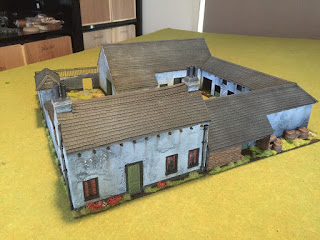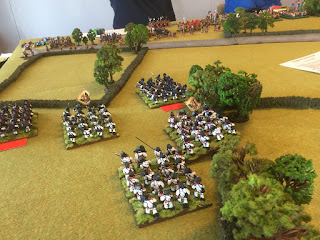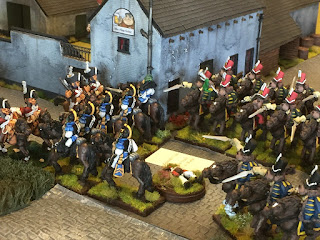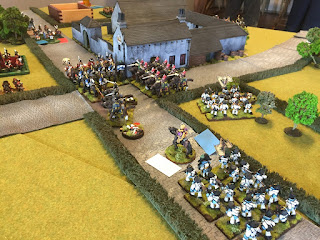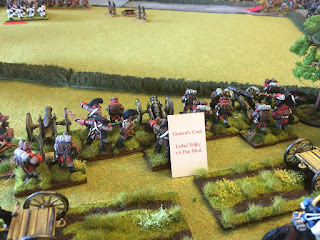Mechwarriors of Fortune – The Missions
Mission Set Up
1) No player can field more than 12 units unless
both players agree.
2) The suggested size of the board to be used is
based on the total number of mechs, vehicles and aerospace fighters in both
forces combined (infantry and battle armour are ignored for determining
battlefield size) per the table below.
3) While
following the table above, the defender is able to choose how many maps will be
used and what maps he will use. If he chooses 2 or 3 maps they must be placed
long edge to long edge. If he chooses 4 or 6 maps they must be placed 2*2 or
2*3, respectively.
4) The attacker chooses which board side he
enters from.
Forced Withdrawal
1) Your employer is paying you to fight and so
you must… up to a point. You can only withdraw one of your own mercenary units
from the field if doing so meets a mission objective (such as the Diversion
mission), if the mission objectives have already been completed, or the unit
meets the conditions of Forced Withdrawal (see below).
2) If a player does withdraw a unit from the
field because it met the conditions for Forced Withdrawal, then this is
considered to signal a General Retreat. From the point all units that meet the
conditions for Forced Withdrawal must withdraw. Only the Company Commander is
able to ignore the General Retreat.
3) Support Units are required to begin
withdrawing from the field as soon as they meet the conditions for Forced
Withdrawal.
4) Units in
Forced Withdrawal do not have to retreat directly from the board – they can
take a less direct route to avoid enemy units, they do not have to expose the
rear of their unit if they don’t want to, and can choose to walk instead of run
towards their board edge if the player want, but within that they should move
as close to their board edge each turn as possible.
5) A mech is considered to meet the conditions
for Forced Withdrawal when any two of the head, legs or front torso locations
have had all their armour removed, or when any leg or torso has been destroyed.
Arms and rear armour locations do not affect forced withdrawal.
6) A vehicle is considered to meet the conditions
for Forced Withdrawal when it has lost all armour in one location, or it has
had its mobility reduced by more than half.
7) Battle armour and infantry are considered to
meet the conditions of Forced Withdrawal when they are reduced to below half
their starting strength.
Crew Survival
1) If a mech was destroyed by a critical hit to
the cockpit or the destruction of the head the pilot is killed automatically.
If a vehicle was taken out by a critical result that killed the crew then you
can wipe them off your roster.
2) If the unit was destroyed in any other way
(two gyro hits, three engine hits, a vehicle losing an entire critical location
etc) then there’s a chance the pilot or crew managed to escape the flaming
wreck. Make an unmodified piloting skill roll, not even modifying for any
damage taken during the battle. If the roll is failed the pilot or crew was
caught in the destruction and killed, but if the roll is passed the crew
managed to escape the wreck in time. Whether your side or the enemy pick them
up is determined in the Wash Up.
Immobilised units
1) If a player’s unit is immobilized the player
can choose to fight on or abandon the unit. The crew exit the vehicle
automatically (no need to test for Crew Survival) but they must still test to
see test to see if your side or the enemy pick them up as per the Wash Up.
2) If a supporting unit is immobilised it is
abandoned automatically. No need to test what happens to the crew of support
units, because no‐one cares.
Ending the
Game
1) Missions will state when the game ends. Most
commonly this will be when the one side or the other has fully retreated from
the map.
2) Games can end before then, though, through
mutually agreed ceasefire. No ceasefire can take place before the end of at least
6 playing turns. This ceasefire should contain agreement on which side is
deemed to have met their objectives, and may include the surrender of one or
more Mechs still on the field, if one player is in a strong enough position to
make such a demand. The terms of ceasefire can include who is deemed in control
of the board (and therefore salvage) but only if that is not automatically
determined by the mission.
Sundry
1) The defender cannot enter a hex with an
objective in it. This does not apply if the objective is a unit, such as the
convoy in Extraction.
2) Players are free to ignore or alter any
mission rules they please, either to allow to avoid a bug in the rules or just
to change things up for fun. Don’t change anything that affects money, though.
3) Players are free to use any other optional
rule out of Tactical Operations if they both agree.
4) One common rule in Tactical Operations that
players might consider makes lighter mechs easier to knock down and heavier
mechs harder to knock down. If players choose they can use an optional rule
when taking piloting skill checks from damage, giving light mechs are a +1
modifier, medium mechs no modifier, heavy mechs a ‐1 modifier, and assault
mechs a ‐2 modifier to their target number.
Escort
The attacker is trying to move a convoy
rapidly across enemy controlled territory. He might be trying to evacuate VIPs
from a city lost to the enemy, or possibly deliver weapons to secret cells
inside enemy territory. The defender has learned of this plan and is moving in
rapidly to intercept the convoy and destroy the cargo.
Set Up
The game is played from narrow board edge to
narrow board edge. For every 50 tons in the attacking force he is given a
Packrat LRPV PKR‐T5 (SRM2) with gunnery and piloting 6/6. With the attacker
deploying first, both players take it in turn to deploy units, with the
attacker deploying along one of the narrow board edges, and the defender
deploying across the full board, but at least 9 hexes from the attacker’s
deployment zone.
Special rules
The
Packrat convoy moves first each turn, before the initiative roll and any other
units have had a chance to move. Attacker forces can withdraw only from the
narrow board edge opposite the board they deployed along, but they can do this
with any unit at any time.
Defender forces can withdraw, if allowed per
the common rules, from either broad board edge.
Game end
The game ends when all the attacking player’s
units and Packrats have either been destroyed or escaped off the board, or when
a ceasefire has been reached.
Attacker Victory Conditions
Complete victory – at least half of the convoy
of Packrats managed to exit the board – 100% of contracted pay, plus the
appropriate faction points.
Defeat – less than half of the convoy of
Packrats managed to exit the board –50% of contracted pay, less the appropriate
faction points.
Defender Victory Conditions
Complete victory – half or less of the trapped
force managed to exit the board – 100% of contracted pay, plus the appropriate
faction points.
Defeat – more than half of the trapped force
managed to exit the board – 50% of contracted pay, less the appropriate faction
points.
Salvage
The defender is deemed in control of the board at the end of the
mission. Even if all defender forces have retreated or been destroyed the
defender claims all salvage, as other forces loyal to the defender’s employer
will soon be in the area.
Diversion
One portion of the attacker’s force has been
trapped by enemy forces, and he is attempting to break those units out by
mounting a diversionary attack. The defender is trying to prevent this, by
destroying as much of the trapped force as possible.
Set Up
The attacker splits his force in to a trapped
force and a diversionary force. Each group must contain half of his total count
of mechs and ground vehicles weighing 20 tons or more (in the event of an odd
number the trapped force should be larger). Airborne units, infantry and battle
armour can be added to each group freely, but don’t count towards either
force’s unit count, and nor will they play a part in determining the victor.
The attacker places his trapped force along
one narrow board edge. None of his trapped force may take advantage of the Air
Deployment special clause. The defender then deploys his full force across the
centre of the board, no closer than 6 hexes from either narrow board edge. The
attacker then places his diversion force along the other narrow board edge.
Special rules
Attacker forces can
withdraw only from the narrow board edge that the diversion force deployed
along, but they can do this with any unit at any time. Defender forces can
withdraw, if allowed per the common rules, from either broad board edge.
Game end
The game ends when all of one player’s units
have left the board, or a ceasefire has been reached.
Attacker Victory Conditions
Complete victory – more than half of the
trapped force managed to exit the board – 100% of contracted pay, plus faction
points.
Defeat – half or less of the trapped force
managed to exit the board –50% of contracted pay, less faction points.
Defender Victory Conditions
Complete victory – half or less of the trapped
force managed to exit the board – 100% of contracted pay, plus faction points.
Defeat – more than half of the trapped force
managed to exit the board – 50% of contracted pay, less faction points.
Salvage
The defender is deemed in control of the board
at the end of the mission. Even if all defender forces have retreated or been
destroyed the defender claims all salvage, as other forces loyal to the
defender’s employer will soon be in the area to close the breach in the line.
Sabotage
The attacker is attempting a rapid raid to
destroy key facilities garrisoned by the defender. Common targets of such a
raid are water treatment facilities and military factories. Each objective is a
level 1 building with a number of structure points equal to one quarter of the
game’s tonnage, rounded up (i.e. a 350 ton game would mean each building had 88
structure points).The defender has been charged with the protection of these
facilities.
Set Up
The battle is fought from narrow edge to
narrow edge. After the attacker has chosen his board edge the defender places 4
objective tokens on the board – these tokens cannot be within 5 hexes of each
other, and cannot be placed in water of more than depth 0.
The defender then deploys his entire force
anywhere on the map, but not within 9 hexes of the edge the attacker is going
to deploy from.
The attacker deploys his forces during the
first turn, moving them on to the map from his attacking board edge.
Special rules
The buildings follow the rules from Total
Warfare – specifically; that they are immobile structures that are ‐4 to be
hit, and will be fully destroyed when they’ve lost all their structure points.
Game end
The game ends when either the attacker has no
units remaining on the board, or both sides have agreed to a cease fire.
Attacker Victory Conditions
For each structure destroyed the attacker
receives 25% of his contracted pay.
Complete Victory ‐ three or four structures
destroyed, receiving the appropriate faction points plus pay as above.
Defeat ‐ zero, one or two structures
destroyed, losing the appropriate faction points plus pay as above.
Defender Victory Conditions
Complete Victory –Zero, one or two structures
destroyed, 100% defender pay and the appropriate faction points.
Defeat –three or four two structures destroyed,
50% of contracted pay and a loss of the appropriate faction points.
Salvage
The defender is deemed in control of the board at the end of the
mission. Even if all defender forces have retreated or been destroyed he will
still claim all salvage, as other forces loyal to the defender’s employer will
soon be in the area.
Rapid Recon
The attackers is attempting to rapidly recon
four points on the map, and then withdraw before larger defender forces in the
area show up. The defender is attempting to delay the attacker from scanning
the four objectives until reinforcements arrive.
Set Up
The battle is fought from narrow edge to
narrow edge. After the attacker has chosen a table edge the defender places
four objective tokens, which must be at least 5 hexes apart and at least 4
hexes from any board edge. The defender then deploys his entire force,
deploying no unit within 6 hexes of the attacker’s board edge. The attacker
then deploys along his board edge.
Special rules
Each turn, after the completion of the heat
phase the attacker can declare if any of his units are attempting to recon an
objective. All the attacker’s mechs and vehicles can attempt to recon an
objective, if it is within LOS. A unit can only attempt to recon one objective
per turn, but any number of units can attempt to recon a single objective each
turn.
To recon an objective, roll 2D6, with a target
number of 7 and the following modifiers; +1 per hex between the unit and the
objective ‐1 if the unit is fitted with TAG
‐2 if the unit is fitted with an active probe
+1 for each hex that passes through defender
ECM (including the objective and the unit’s hex)
+1 for each hex that includes a heavy or light
wood (not including the objective and the unit’s hex)
You can continue to recon objectives while in
forced withdrawal, either due to damage or to passing turn eight (see below).
Game end
Once all attacker units have left the area or
both sides agree to a cease fire the game ends.
At the end of 8 turns all attacker units are treated as if they
suffering from forced withdrawal, and begin withdrawing towards their
deployment area. This represents the need for these units to leave the area
before larger enemy forces enter the area. Any attacker units which are
immobilized and cannot retreat from the area will be abandoned to the enemy as
soon as all mobile forces have left the area.
Attacker Victory Conditions
The attacker will be paid 25% of his
contracted pay for each location that he successfully scans.
Complete Victory ‐ three or four objectives
scanned, you gain the appropriate faction points plus pay as above.
Defeat ‐ zero, one or two objectives scanned,
you lose the appropriate faction points plus pay as above.
Defender Victory Conditions
Complete victory – zero, one or two of the
objectives are scanned – 100% of contracted pay plus faction points.
Defeat – three or four objectives are scanned
– 50% of contracted pay and minus the appropriate faction points.
Salvage
The defender is deemed in control of the board at the end of the
mission. Even if all defender forces have retreated or been destroyed he will
still claim all salvage, as other forces loyal to the defender’s employer will
soon be in the area.
Any immobile attacking units on the board at
the end of the game are assumed to be abandoned as salvage to the defender.
Take the Position
The attacker has been ordered to seize a key
high point in the enemy’s main line. The defender has been ordered to hold the
line, no matter the cost.
Set Up
The attacker can choose any board edge to
deploy along. The defender then picks a high point in the half of the board
opposite the attacker’s board edge and marks it with an objective token – it
doesn’t have to be the highest point on the map but it should be at least as
high as any other point within 6 hexes. The defender then deploys his force
anywhere on the board, as long as it is at least 6 hexes from the attacker’s
deployment zone. The attacker then deploys his units along his deployment zone.
Special rules
For the purposes of determining victory only
ground based units with a tonnage of 20 or greater are counted.
Game end
The game ends when one side has fully
retreated from the board, both sides agree to a cease fire.
Attacker Victory Conditions
Complete Victory – The
objective is the target hex and all adjacent hexes (an area seven hexes large
in total). He will achieve complete victory if at the end of any turn he has
25% or more of his total ground force’s total tonnage in the area, while at the
same time the defender has no units in that area. If he can manage this he can
claim full pay plus faction points.
Defeat – If the attacker cannot manage to
complete the above within 10 turns he has been defeated – and will receive only
50% pay and the appropriate reduction in faction points.
Defender Victory Conditions
Complete victory – If the game has 10
completed turns without the attacker managing to complete his objective then
the defender has won – full pay plus the appropriate faction points.
Defeat – If the attacker meets his objective
then the defender has been defeated – 50% pay minus the appropriate faction
points.
Salvage
Control of the battlefield continues after the time limit. While the
objective might have been taken or not, the game only ends when one player has
retreated, or a ceasefire has been reached granting one side or the other
control of the battlefield.
Extraction
The attacker is attempting to recover a VIP,
key piece of technology, military secrets or some similar item. The defender is
attempting to prevent this happening.
Set Up
The attacker can choose any board edge to
deploy along. The defender then picks a single point on the map and places an
objective marker on the map – the point chosen can’t be with six hexes of any
board edge or a water hex. The defender then places all his forces, not placing
any unit within 6 hexes of the attacker’s deployment zone. The attacker then
deploys his units along his deployment zone.
Special rules
To collect the objective the attacker must
move in to the hex containing the objective, while there are no enemy units in
the hex. If he does not fire or make any physical attacks that turn he can
attempt to extract the target at the end of the turn, after the heat phase.
To successfully collect the objective you must
make beat a target number of 5, plus the movement modifier for how far that it
travelled that turn (moved 5 hexes, +2 target number).
The target number is reduced by 1 if you have
one or more working hand actuators.
A unit carrying the objective can always leave
the board through the attacker’s deployment zone.
If a unit carrying the extraction token is
destroyed, the token is left in the square where the unit was destroyed.
Another attacking unit is free to attempt to
collect the objective, and move it off the board.
A unit can voluntarily choose to drop the
objective, this can be done automatically, costs nothing and can be done at any
point during their movement, but another unit cannot pick up the objective
until the next turn (and they must roll to pick it up as above).
Game end
The game ends when all mobile attacking units
have left the board through their deployment zone.
At the end of 10 turns all attacker units are treated as if they were
suffering from forced withdrawal, and begin withdrawing towards their
deployment area. This represents the need for these units to leave the area
before larger enemy forces enter the area. Any attacker units which are
immobilized and cannot retreat from the area will be abandoned to the enemy as soon
as all mobile forces have left the area.
A unit can ignore the forced withdrawal
requirement above if it is moving in to a hex containing the objective.
Attacker Victory Conditions
Complete victory – If the attacker extracts
the objective out of his deployment area, he claims 100% pay and the
appropriate faction points.
Defeat – If the objective is still on the map
when the game ends the attacker claims 50% pay and minus the appropriate
faction points.
Defender Victory Conditions
Complete victory – If the objective is still
on the map when the game ends the defender claims 100% pay and the appropriate
faction points.
Defeat – If the attacker managed to take the
objective off of the board, the defender receives 50% pay and minus the
appropriate faction points.
Salvage
The defender is deemed in control of the board at the end of the
mission. Even if all defender forces have retreated or been destroyed he will
still claim all salvage, as other forces loyal to the defender’s employer will
soon be in the area.
Open Engagement
Objective
This is a straight up fight. The attacker is
advancing in to enemy held territory with the intent of destroying as much of
the enemy as they can and forcing the rest to retreat. The defender is meeting
the attacker with full force, planning to keep control of the area by
destroying the attacking units.
Set Up
The attacker can choose any board edge. The
defender’s deployment zone is the opposite board edge. Both sides take it in
turns to deploy along their deployment zones.
Special rules
None.
Game end
The game ends when one side or the other has
retreated all their forces from the board.
Attacker Victory Conditions
Complete victory – If the defender has
retreated all his units from the board, then the attacker has won, and can
claim 100% of pay and the appropriate faction points.
Defeat – If the attacker has retreated all his
units from the board, then the attacker has lost, and receives only 50% pay and
loses the appropriate faction points.
Defender Victory Conditions
Complete victory – If the attacker has
retreated all his units from the board, then the defender has won, and receives
100% of pay and the appropriate faction points.
Defeat – If the defender has retreated all his units from the board,
then the defender has lost, and receives only 50% pay and minus the appropriate
faction points.
Salvage
Whoever wins claims the area and is in control
of all salvage left on the board.
Assassination
Objective
Both sides are attempting to reduce the
fighting strength of the other side. To do this they’re attempting to cripple
or destroy the most valuable unit in the enemy force.
Set Up
The attacker can choose any board edge. The
defender’s deployment zone is the opposite board edge. Both sides take it in
turns to deploy along their deployment zones.
Special rules
The most valuable ground unit in each force is
the ‘target’. Supporting Units cannot be the targeted unit. You cannot deploy
your target as hidden. If your targeted unit meets the conditions for Forced
Withdrawal you may retreat it from the map, but doing so will cost you the
mission. The target can ignore a General Retreat if you want.
Game end
The game continues even after the target has
been taken down or retreated from the map. The mission ends only through a
cease fire, or when one side or the other has fully retreated from the board.
Attacker Victory Conditions
Complete victory – If the attacker manages to
destroy or force from the board the defender’s target before the defender
manages to do the same to him, the attacker receives 100% pay and the
appropriate faction points. Draw – If the both the attacker and defender’s
targets are destroyed or retreat from the map in the same sequence (ie both are
destroyed in the same weapon attack phase) then the game is a draw and the
attacker receives 75% of his pay, he receives half the faction points of a win,
but with no bonus skill points for being the winning attacker. Defeat – If the
attacker’s target is destroyed he retreats it from the board while the
defender’s target is still on the board and operational, the attacker is
defeated and receives just 50% pay and minus the appropriate faction points.
Defender Victory Conditions
Complete victory – If the defender manages to
destroy or force from the board the attacker’s target before the attacker
manages to do the same to him, the defender receives 100% pay and the
appropriate faction points. Draw ‐ If the both the attacker and defender’s
targets are destroyed or retreat from the map in the same sequence (ie both are
destroyed in the same weapon attack phase) then the game is a draw and the
defender receives 75% of his pay and faction points are awarded as if he’d won.
Defeat – If the defender’s target is destroyed or retreats from the
board while the attacker’s target is still on the board and operational, the
defender is defeated and receives just 50% pay and minus the appropriate
faction points.
Salvage
Whoever remains on the board once the other side has retreated can
claim all salvage.
Break the Line
Objective
The attacker is attempting to punch through an
open area in the defender’s front line, either to begin raiding, or to attack
logistics points or something like that – whatever it is they have to get
through fast and keep on going. The defender is rushing in to the area to
prevent the breach or at least slow it down enough to allow other units to
adjust.
Set Up
The defender must set up four game boards. The
attacker chooses one of the short board edges. The defenders deployment zone is
both of the long board edges. With the attacker going first, both sides take it
in turns to deploy along their deployment zones.
Special rules
All ground based units in the attacker’s force
that weigh 20 tons or more are considered the ‘raiding force’. It is only these
units that will determine whether the mission has succeeded or not. He is
attempting to exit this raiding force from the edge opposite his deployment. He
can also withdraw units from his original deployment edge, per the common
rules. The defender can retreat units from either long board edge, per the
common rules.
Game end
The game continues until one side or the other
has exited all forces from the map, or if a ceasefire has been reached.
Attacker Victory Conditions
Complete victory – If the attacker gets
managed to get more than half of his raiding force off the opposite board edge
within 8 turns, with walking/crusing MP at least half what they started with,
then the attacker receives 100% pay and the appropriate faction points.
Defeat – If the attacker fails to do the above
he is defeated and receives just 50% pay and loses the appropriate faction
points.
Defender Victory Conditions
Complete victory – If the defender manages to
prevent the attacker getting more than half his raiding force off the opposite
board edge within 8 turns, he receives 100% pay and the appropriate faction
points.
Defeat – If the attacker meets his mission
conditions then the defender has lost and receives just 50% pay and loses the
appropriate faction points.
Salvage
The defender is deemed in control of the board
at the end of the mission. Even if all defender forces have retreated or been
destroyed he will still claim all salvage, as other forces loyal to the
defender’s employer will soon be in the area.


